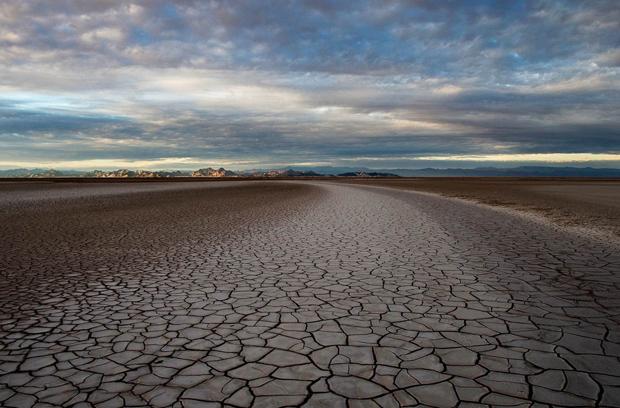New U.S.-Mexico agreement promises to restore water to Colorado River delta
The Colorado River is just a dry mud bed where it once met the Gulf of California, in Mexico. (Photo by Peter McBride.)
The Colorado River runs 1,450 miles. It starts in the Rocky Mountains of Colorado, then winds its way through Utah, Arizona, Nevada and California.
It crosses the border into Mexico and ends at the Sea of Cortez. Or more accurately, that’s where the riverbed ends.
The water stops flowing about 75 miles shy of its natural conclusion.
As urban areas and agricultural demands have increased up river, both in the United States and Mexico, the area down river, a vast expanse called the Colorado River Delta, has paid the price.
“The delta at one time was enormous. If it were in existence today I would speculate that it would be one of the eight wonders of the world, it was that massive and impressive a place,” said Patrick Graham with The Nature Conservancy in Arizona. “Today, it’s basically a dried mudflat.”
It’s been like this for nearly a half century, since the Glen Canyon Dam began holding back water in Arizona in 1960. Since then, only the wettest years have allowed some water to reach all the way to the delta.
Under a new agreement reached last week, the United States will get more water during times of drought. And in times of plenty, Mexico will be able to store excess water north of the border. But the Colorado River Delta also stands to benefit.
That’s welcome news to people like Francisco Zamora, who directs the Sonoran Institute’s Colorado River Delta program. He said when his group planted trees last year on 50 acres in the delta and provided a tiny amount of water for irrigation, the trees quickly bloomed.
“It’s really amazing how fast they grow and how quickly they produce habitat. We’ve seen many species of birds using the habitat, and other wildlife,” he said. “Mammals and the bobcat, and there are a few beavers we’ve seen along the river.”
Al from a tiny amount of water. Under the agreement reached this week, more than a thousand times as much water will be added to the delta, over a five-year period.
This water will come from Mexico’s share of the river. Or more specifically, from Mexican farmers who are willing to sell back some water on the open market. Overall, the plan calls for Mexican farmers to give back about three percent of their water allocation.
This loss should be offset by planned improvements to irrigation canals in Mexico.
There’s another source of water that’ll be coming to the Delta. Under the five-year agreement, there will also be a special, one-time only burst of water sent down river. This water is being collected and stored north of the border. And when it is released, all at once, it will mimic a natural springtime flow from a wet year.
Zamora says it’s not hard to predict what will happen.
“It will create a functional ecosystem that will benefit the species. And that’s what we learned, the delta is very resilient,” he explained. “You add water and the habitat comes back, the birds come back, the wildlife comes back. And that’s why the delta is a good example of hope.”
Zamora talks optimistically about the regeneration of endangered birds and fish in both Mexico and the southwestern United States. He also talks about the resurgence of commercial fish and recreational opportunities in the Delta.
“The way I describe it is we are kind of reconnecting the people with the river,” he said.
And while this is undoubtedly good news for the conservation movement in Mexico and the southwestern United States, the amounts of water being restored to the Delta will be far smaller than what would’ve happened naturally 150 years ago.
The magnificent delta of old will likely never be restored, as least as long as people are around.
Graham said the new agreement is just a first step.
“But it’s a good first step, because for the first time the environment has been factored into these water management decisions at this scale,” he said. “And it’s not only important ecologically, but I think symbolically to provide the opportunity to restore the river, the delta.”
The new agreement could begin delivering additional water to the delta as early next spring.
We want to hear your feedback so we can keep improving our website, theworld.org. Please fill out this quick survey and let us know your thoughts (your answers will be anonymous). Thanks for your time!
